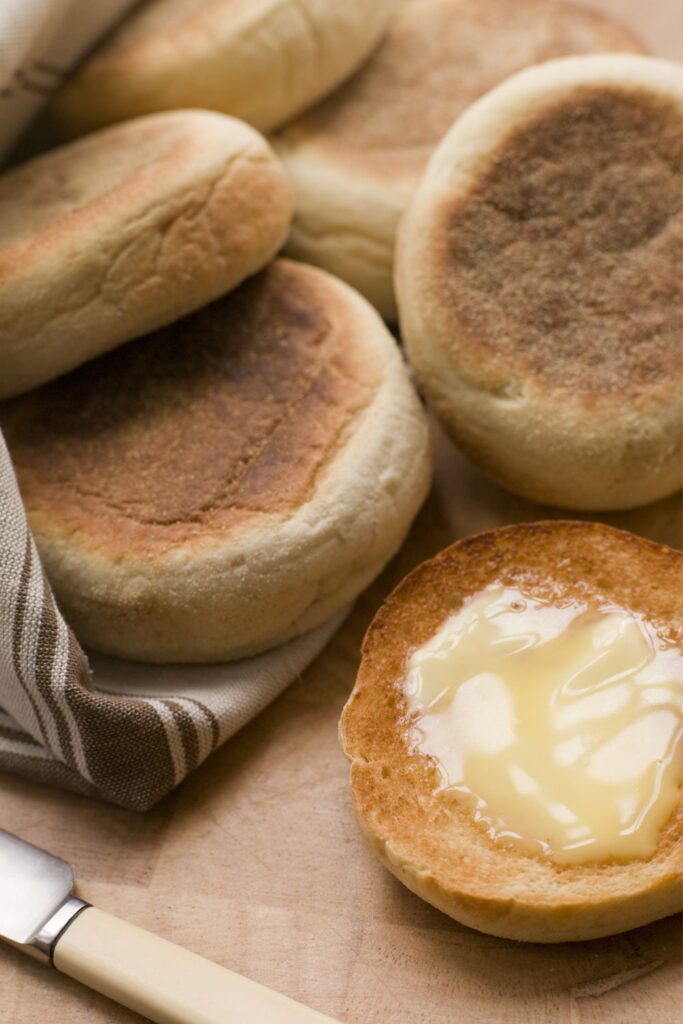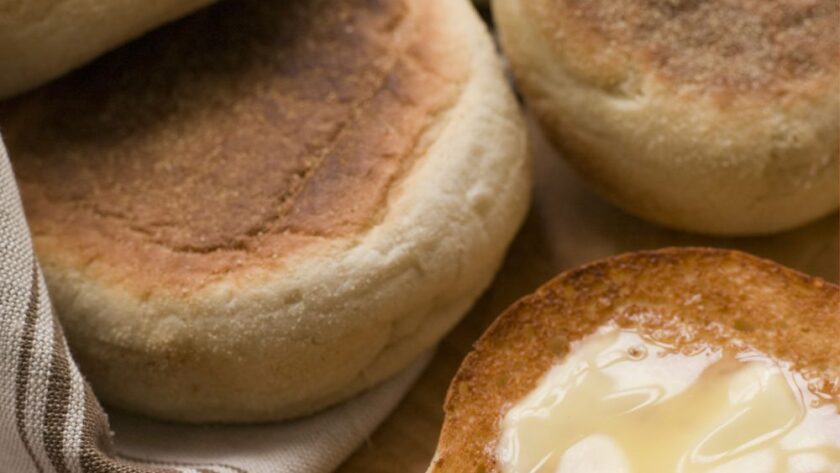The first time I tried making English muffins at home, I was chasing that perfect café-style breakfast—soft inside, golden outside, and full of those little nooks that catch all the butter. Mine? Flat, tough, and oddly biscuit-like. I’d rolled the dough too thin, skipped the proper rise, and cooked them on a pan that was far too hot. They were more “pancake in disguise” than classic muffin.
But once I slowed down, gave the dough a proper rest, and treated the griddle with care, they turned out exactly as they should: light, chewy, and satisfying to tear open by hand. Now I make them on slow mornings or batch them for the freezer—and I never slice them with a knife again. Here’s how to get it right from the start.
Why This One Works So Well
There’s no baking involved here—these are griddle-cooked breads, and that’s part of what makes them special. It’s a dough that relies on patience and just the right amount of heat.
- Strong white flour creates structure and chew—plain flour won’t cut it.
- Slow rise gives the muffins time to develop their airy interior.
- Griddle-cooking means crisp outsides and fluffy middles—without turning on the oven.
It’s a simple dough, but the technique is what makes these sing.
Ingredients + Why They Matter
- Strong white flour (675g) – Essential for chew and rise. Don’t swap it unless you’re after a softer, cakier muffin.
- Caster sugar (2 tsp) – A hint of sweetness that balances the salt and feeds the yeast.
- Fast-action yeast (7g) – Easy, reliable. No need to proof separately—just mix in.
- Salt (1½ tsp) – Enhances flavour. Keep it away from the yeast when mixing dry.
- Tepid milk (450ml) – Warm to the touch, not hot. Activates the yeast and adds richness.
- Fine semolina (1 tsp) – Dusting the tray and tops gives a slight crunch and stops sticking.
- Oil – For greasing the pan. Helps the crust form without smoking up the kitchen.
Making It Yours (Without Ruining It)
- Dairy-free? Use warm oat or soy milk. I’ve tried it—it still works well.
- Mini muffins? Use a smaller cutter and cook for less time. Perfect for snacks or sliders.
- Want extra flavour? Add a pinch of dried herbs or grated cheese into the dough before kneading.
Mistakes I’ve Made (And How to Avoid Them)
| What Went Wrong | Why It Happens | How to Fix It |
|---|---|---|
| Muffins didn’t rise | Dough was under-proofed or cold | Give it time—wait until doubled in size |
| Outside browned too fast | Pan too hot | Use medium-low heat and adjust as needed |
| Texture was dense | Overworked dough or weak flour | Use strong flour and knead until elastic |
| Stuck to the tray | Skipped the semolina dusting | Dust generously top and bottom |
How to Make Mary Berry’s English Muffins
- Mix the dough – In a large bowl or stand mixer, combine flour, sugar, yeast, and salt (keep yeast and salt on opposite sides). Gradually pour in tepid milk, mixing to form a soft dough.
- Knead until smooth – By hand or dough hook, knead for about 10 minutes until smooth and springy.
- Roll and cut – On a floured surface, roll dough to 1cm thickness. Cut rounds using a 7.5cm cutter. Place on a floured tray and dust tops with semolina.
- Let rise – Cover loosely and leave in a warm spot for 1 hour or until doubled in size.
- Cook on the griddle – Lightly oil a heavy frying pan or griddle. Cook muffins in batches over medium-low heat for 7 minutes per side. Adjust heat as needed to avoid burning.
- Cool and serve – Let cool slightly on a rack. Pull apart with fingers for that soft, open texture.

Tips from My Kitchen
- I warm my milk slightly in the microwave for 30 seconds—just to take the chill off.
- Use a dry frying pan to test heat: sprinkle flour and if it browns in 30 seconds, you’re good.
- If your kitchen’s cold, I rise the dough in the microwave—just heat a cup of water first and let the dough sit beside it.
- Store cooled muffins in a tin lined with baking paper—helps keep the crust crisp.
Storage + Serving
- Room temp (2–3 days) – Keep in a tin or airtight box. Best toasted before serving.
- Fridge (up to 5 days) – Okay, but they can dry out—toast to revive them.
- Freezer (up to 3 months) – Split before freezing for easy toasting. Wrap well.
- Reheat – Straight from frozen into the toaster. No defrosting needed.
FREQUENTLY ASKED QUESTIONS
Q: Can I bake these in the oven instead?
A: Not really. The griddle gives them their unique crust and colour. Baking changes the texture.
Q: What should the inside look like?
A: Light, fluffy, with open bubbles—not dense or gummy. If they’re doughy, try lowering the heat next time.
Q: Why pull instead of slice?
A: Tearing keeps the nooks and crannies intact for all that melted butter to hide in. A knife flattens them.
Q: Can I make the dough ahead?
A: Yes—let it rise once, shape, then cover and chill overnight. Bring to room temp before cooking.
Q: What do I serve with them?
A: Butter and jam is the classic. But also: poached eggs, bacon, smoked salmon, or even just a swipe of Marmite.
Try More Recipes:
- Mary Berry Double Chocolate Chip Muffins
- Mary Berry Blueberry Muffin Recipe
- Mary Berry Chocolate Chip American Muffins
Mary Berry English Muffins
Course: BreakfastCuisine: BritishDifficulty: Easy12
servings20
minutes14
minutes190
kcalSoft, Chewy English Muffins With A Golden Crust—Perfect Pulled Apart And Slathered With Butter For Breakfast Or Teatime.
Ingredients
675g strong white flour
2 tsp caster sugar
7g fast-action yeast
1½ tsp salt
450ml tepid milk
1 tsp fine semolina
Oil for greasing
Directions
- In a bowl or stand mixer, mix flour, sugar, yeast, and salt. Gradually add milk and knead until smooth.
- Roll out dough to 1cm thick. Cut with 7.5cm cutter. Place on floured tray, dust tops with semolina.
- Cover and rise for 1 hour until doubled.
- Heat a lightly oiled griddle or frying pan on medium-low. Cook muffins for 7 minutes per side.
- Cool on a wire rack. Pull apart and serve warm with butter.
Notes
- I warm my milk slightly in the microwave for 30 seconds—just to take the chill off.
- Use a dry frying pan to test heat: sprinkle flour and if it browns in 30 seconds, you’re good.
- If your kitchen’s cold, I rise the dough in the microwave—just heat a cup of water first and let the dough sit beside it.
- Store cooled muffins in a tin lined with baking paper—helps keep the crust crisp.
